Jan 28, 2011 | history, national park quarters, US Mint, video
The Battle of Gettyburg was the pivotal battle of the Civil War. The three day battle (July 1-3, 1863) started when Confederate General Robert E. Lee attacked the Union position in an attempt to invade the North after successful battles in Northern Virginia. Gettysburg was defended by Major General George G. Meade who arrived at Gettysburg three days before the battle began. The Confederate Army began its Retreat from Gettysburg on July 4, 1863 following the resounding defeat after (Maj. Gen. George) Pickett’s Charge on Cemetery Hill.
The Battle of Gettysburg is considered the turning point of the American Civil War because of the morale boost it provided the Union forces. But when the battle was over, there was no mistaking the cost of this battle in that between 46,000 and 51,000 Americans died on the battlefield.
The Gettysburg National Cemetery was dedicated on November 19, 1863 with speeches from Edward Everett and President Abraham Lincoln. Everett’s two-hour formal speech at the event preceded Lincoln’s 271-word Gettysburg Address, a speech that proved Lincoln was not a good prognosticator: “The world will little note, nor long remember what we say here….”
The Gettysburg National Military Park came into existence on February 11, 1895 when President Grover Cleveland signed the legislation into law. Originally, the law required the park was to be administered by the War Department. In 1933, control was passed to the National Park Service.
On January 25, 2011, the U.S. Mint launched the The Gettysburg National Military Park Quarter held at park’s Museum and Visitors Center. U.S. Mint Associate Director for Sales and Marketing B. B. Craig and Gettysburg National Military Park Superintendent Bob Kirby co-hosted the event, with Barbara Finfrock, vice chair of the Gettysburg Foundation, serving as master of ceremonies.
The reverse of the quarter depicts the 72nd Pennsylvania Infantry Monument, which is located on the battle line of the Union Army at Cemetery Ridge. It was designed by Artistic Infusion Program Master Designer Joel Iskowitz and engraved by U.S. Mint Sculptor-Engraver Phebe Hemphill.
As with previous releases, the U.S. Mint released an edited B-roll video of the launch with highlights, scenery, production footage.
This is the first quarter in the America the Beautiful Quarters Program representing a piece of United States history. We should always note and long remember what happened in Gettysburg and learn about the events leading up to the worst conflict in U.S. history so that we may never relive that history again.
Jan 24, 2011 | national park quarters, US Mint
Followers of the U.S. Mint may have read the announcement that the launch launch of the 2011 Gettysburg National Military Park quarter will be held Tuesday, January 25 at 11:00 A.M (Eastern Time) at the Gettysburg National Military Park Museum and Visitor Center. The public event will include a cash exchange for $10 rolls of the new quarters. Attendees 18 years old and younger will receive a free quarter to commemorate the event.
After the launch ceremony, the U.S. Mint will host a forum where the public will have an opportunity to ask questions and share their ideas about the future of the Nation’s coinage. The forum will be held Monday, January 24 at 5:30 p.m. ET in the Ford Motor Company Fund Education Center at the Gettysburg National Military Park Museum and Visitor Center. No word as to whether someone from the Citizens Coinage Advisory Committee will be at this forum.
What the announcement did not include was that B. B. Craig, the Associate Director of Sales and Marketing for the U.S. Mint, will be the Mint’s representative at these events. In checking the 2008 Plum Book, the Associate Director of Sales and Marketing is not listed as a policy or supporting position. Thus, Mr. Craig may be a career professional stepping up to represent the U.S. Mint. Regardless of what you read in the press or hear from politicians, government career professionals are hard working citizens doing the jobs prescribed by the laws passed by congress on behalf of the American people. I wish Mr. Craig well in his appearance!
Dec 12, 2010 | bullion, coins, dollar, national park quarters, US Mint
It is difficult to determine if 2010 was a good year for those collecting coins from the U.S. Mint. Unlike 2009, the U.S. Mint was able to strike both bullion and proof American Silver Eagle and American Gold Eagle coins. After the outrage of 2009, collectors appear to be happy that the proof Eagles have made a return.
Also new in 2010 were the American the Beautiful Quarters program with designs representing the first five national parks created by an act of congress. As part of each park’s introduction, either Director Edmund Moy or Associate Director Andy Brunhart has visited each of the 2010 celebrated sites for the introduction of the new quarters. Although it has been difficult finding these quarters in pocket change, these new coins had nice designs and was a chance for people to learn about the United State’s wonderful national parks.
Bullion
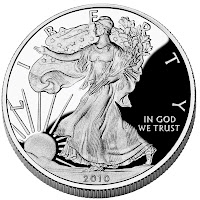 Bullion programs have caused angst amongst collectors and the U.S. Mint. Collectors found their collections with holes for the 2009 American Eagle Proof coins while waiting close to the end of 2010 to find out that proof Eagles will be produced.
Bullion programs have caused angst amongst collectors and the U.S. Mint. Collectors found their collections with holes for the 2009 American Eagle Proof coins while waiting close to the end of 2010 to find out that proof Eagles will be produced.
Sales of bullion American Eagles have had mixed results. While the U.S. Mint has not produced bullion Platinum Eagles since 2008, sale of gold bullion has dropped from 2009. With the price of gold climbing from $1,100 at the beginning of the year to over $1,300 since September, investors may be looking for more cost effective investment option.
One investment option has been silver. With over 33 million silver Eagles produced through the first week of December, the U.S. Mint has produced more silver Eagles this year than in any years since the program started in 1986. Silver started the year around $17 per ounce, staggered into March, and then the prices began a slow rise. After breaking the $20 mark in September, the price has been hovering close to $30 the last few weeks. Silver closed at $30.50 on December 7 before dropping below $29 since.
From a collector’s perspective, this has made collecting American Eagles more expensive. Thankfully, the U.S. Mint has resolved its production issues and produced proof Eagles this year. We will see proof Eagles in 2011 with the passage of the Coin Modernization, Oversight, and Continuity Act of 2010 that changes the American Eagle Bullion law to allow the U.S. Mint to divert some metals for collectors coins.
Missing from the 2010 line up was the American Buffalo 24-karat Gold Coin. While still an authorized issued, the coin has not roamed the United States since 2008 in both bullion and proof issues. There has been no comment from the U.S. Mint as to whether the coins will make an appearance in 2011.
Circulating Coins
For 2011, the U.S. Mint will produce the Lincoln Cent as redesigned in 2010, the Jefferson Nickel that was redesigned in 2006, the Roosevelt Dime as it was designed in 1946, and the Kennedy Half Dollar as it was released in 1964. No changes are planned for these circulating issues.
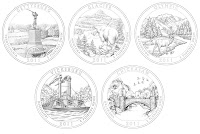 In the second year of the American the Beautiful Quarters Program. If the second year designs are as well executed as the first year, the program will continue to be a success from a collector perspective. The second group of quarters will honor Gettysburg National Military Park in Pennsylvania, Glacier National Park in Montana, Olympic National Park in Washington, Vicksburg National Military Park in Mississippi, and Chickasaw National Recreation Area in Oklahoma. The U.S. Mint’s line art shows promise for a very nice looking series.
In the second year of the American the Beautiful Quarters Program. If the second year designs are as well executed as the first year, the program will continue to be a success from a collector perspective. The second group of quarters will honor Gettysburg National Military Park in Pennsylvania, Glacier National Park in Montana, Olympic National Park in Washington, Vicksburg National Military Park in Mississippi, and Chickasaw National Recreation Area in Oklahoma. The U.S. Mint’s line art shows promise for a very nice looking series.
One part of the American the Beautiful Quarters Program has been the issue of three-inch five-ounce .999 silver bullion coins. Production problems have delayed the release of these coins. According to the U.S. Mint’s press release, there may be collector versions of the coin with limited production runs. Considering the high costs set by the U.S. Mint, it may be difficult for some collectors to justify. But with the production issues worked out, maybe the 2011 versions may sell better.
Dollars
 For the third year of the Native American $1 Coin program, the theme for 2011 is “Supreme Sachem Ousamequin, Massasoit of the Great Wampanoag Nation Creates Alliance with Settlers at Plymouth Bay (1621)” celebrating one of the first peace treaties between the Native Americans and the Puritans who settled at Plymouth Bay. The reverse of the coin depicts the hands of the Supreme Sachem Ousamequin Massasoit and Governor John Carver symbolically offering the ceremonial peace pipe after the initiation of the first formal written peace treaty. The designs of the Native American coins have been so well thought out and executed that this one will be a wonderful addition to your collection.
For the third year of the Native American $1 Coin program, the theme for 2011 is “Supreme Sachem Ousamequin, Massasoit of the Great Wampanoag Nation Creates Alliance with Settlers at Plymouth Bay (1621)” celebrating one of the first peace treaties between the Native Americans and the Puritans who settled at Plymouth Bay. The reverse of the coin depicts the hands of the Supreme Sachem Ousamequin Massasoit and Governor John Carver symbolically offering the ceremonial peace pipe after the initiation of the first formal written peace treaty. The designs of the Native American coins have been so well thought out and executed that this one will be a wonderful addition to your collection.
Continuing the Presidential $1 Coin program, the 2011 coins will honor Presidents Andrew Johnson, Ulysses S. Grant, Rutherford B. Hayes, and James A. Garfield. History buffs will begin with President Johnson who was the first president that was impeached but not convicted, followed by three bearded Republicans who started and perpetuated reconstruction through the 19th century. The 2011 series ends with President Garfield whose 200 day term ended with his death on September 18, 1881.
Those collecting the First Spouse Gold Coins will have a year where all four issues will depict the First Lady’s of the era. Standing behind or along side the Presidents where Eliza Johnson, Julia Grant, Lucy Hayes, and Lucretia Garfield. Remember, if you cannot afford the gold coins, the U.S. Mint sells bronze medals using the same design but without the denomination.
Commemoratives
 Collectors of commemorative coins will have two multi-coin commemorative issues in 2011, both with a military theme. The first commemorative will be the United States Army Commemorative to honor the history of the U.S. Army from the Revolutionary War through today. The U.S. Army Commemorative will be a three-coin set consisting of a gold $5 proof, silver $1 proof, and cupronickel clad half-dollar proof. The obverse of the gold coin represents the U.S. Army’s war service from the Revolutionary War through today. It features a representation of Continental, Civil War, modern, World War II and World War I soldiers. The reverse is based on the official U.S. Army emblem and represents the unbroken history of loyalty and commitment to defend the Nation.
Collectors of commemorative coins will have two multi-coin commemorative issues in 2011, both with a military theme. The first commemorative will be the United States Army Commemorative to honor the history of the U.S. Army from the Revolutionary War through today. The U.S. Army Commemorative will be a three-coin set consisting of a gold $5 proof, silver $1 proof, and cupronickel clad half-dollar proof. The obverse of the gold coin represents the U.S. Army’s war service from the Revolutionary War through today. It features a representation of Continental, Civil War, modern, World War II and World War I soldiers. The reverse is based on the official U.S. Army emblem and represents the unbroken history of loyalty and commitment to defend the Nation.
The obverse of the silver proof depicts the busts of a male and female soldier, symbolizing worldwide deployment of the 21st century U.S. Army. On the reverse, the design symbolizes the seven core values of the U.S. Army featuring an image of the Great Seal of the United States that has been worn on U.S. Army dress and service uniforms since the early 19th Century.
The obverse of the clad half-dollar proof represents the significant contributions of the U.S. Army during peacetime and features a U.S. Army soldier surveying, two servicemen building a flood wall and a Redstone Army rocket used during early space exploration. The reverse design symbolizes the U.S. Army as the first military service to defend the country and its key role in the Nation’s internal development. It features an enlisted Continental soldier armed with a musket and 13 stars representing the original Colonies.
Mintage is limited to 100,000 gold, 500,000 silver, and 750,000 clad coins. The sales price will include a $35 surcharge for each gold coin, a $10 surcharge for each silver coin, and $5 for each clad coin sold. Proceeds from the sales of this commemorative ($12.25 million if all coins are sold) will go to the construction of the National Museum of the United States Army.
 The other commemorative will be the 2011 Medal of Honor Commemorative Coin program. This two-coin set features a $5 gold proof and $1 silver proof coin. The obverse of the gold coin depicts the original Medal of Honor designed in 1861 by the U.S. Mint. The reverse design of the gold coin features Minerva, the Roman goddess wisdom and war, who is featured on the medals. Minerva is standing with a shield representing the Army and Navy in her right hand and the Union flag in her left hand. She is flanked by a field artillery cannon and wheel of the Civil War era.
The other commemorative will be the 2011 Medal of Honor Commemorative Coin program. This two-coin set features a $5 gold proof and $1 silver proof coin. The obverse of the gold coin depicts the original Medal of Honor designed in 1861 by the U.S. Mint. The reverse design of the gold coin features Minerva, the Roman goddess wisdom and war, who is featured on the medals. Minerva is standing with a shield representing the Army and Navy in her right hand and the Union flag in her left hand. She is flanked by a field artillery cannon and wheel of the Civil War era.
The obverse of the silver commemorative coin will feature the three current Army, Navy, and Air Force medals with their ribbon and the connecting pad featuring 13 stars. Since the Medal of Honor is the only medal not pinned to the uniform, it was important to depict the ribbon that is used to wear the medal around the recipient’s neck. The reverse design depicts an Army infantry soldier carrying a wounded soldier to safety under enemy fire. This image conveys the courage, selfless sacrifice and patriotism of Medal of Honor recipients.
Mintage is limited to 100,000 gold and 500,000 silver coins. The sales price will include a $35 surcharge for each gold coin and a $10 surcharge for each silver coin sold. Proceeds for the sale ($8.5 million if sold out) will be distributed to the Congressional Medal of Honor Foundation to support their educational, scholarship and outreach programs.
It appears that 2010 was better than 2009 as the economy improved. Maybe there will be more of a recovery to help make 2011 even better.
Click on any image to see the larger version.
Coin images courtesy of the U.S. Mint.
Dec 2, 2010 | bullion, legislative, national park quarters, palladium, US Mint
In a rare move of bipartisanship, the Senate passed two bills coin-related bills by Unanimous Consent on Tuesday that were previously passed by the House of Representatives. Bills passed by Unanimous Consent are agree upon by both party’s leaders and a voice vote is taken on the floor as a formality. No record of the vote is taken.
The first bill that passed is the Coin Modernization, Oversight, and Continuity Act of 2010 (H.R.6166). Introduced by Melvin Watt (D-NC), Chairman of the Subcommittee on Domestic Monetary Policy and Technology following the hearing of “The State of U.S. Coins and Currency” held on July 20, 2010. As passed, the law requires the U.S. Mint to research minting metals used for coining money and to report to congress what changes should be made to prevent coin production from costing more than its face value. One forward thinking aspect of the law is that it requires to U.S. Mint to tie the research to actual production numbers, as opposed to hypothetical figures. The U.S. Mint has two years to complete the research and report back to the subcommittee.
H.R.6166 also includes two technical changes to the law that will affect collectors. One change allows the U.S. Mint to change size of the planchet used for the National Park Bullion Program from 3-inches to a size between 2.5 and 3-inches. This will help the U.S. Mint deal with technical issues that has delayed the issue of the five ounce bullion coins.
For fans of the American Eagle proof programs, a wording change in the law allows the U.S. Mint to divert gold and silver to meet the demand for numismatic collectible coins. The change does not set minimum or maximum limits of coins struck but it will prevent future gaps in our collections.
Speaking of the American Eagle program, the Senate also passed the American Eagle Palladium Bullion Coin Act of 2010 (H.R.6166). The bill was introduced by Rep. Dennis Rehberg (R-MT) in support of the primary support of palladium mining in Montana where 95-percent of all United States palladium deposits are. The new law will add a one-ounce .9995 fine palladium bullion coin to the American Eagle Bullion Program. 
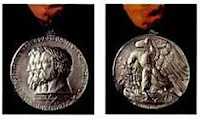 The coin will have a $25 face value and require that “the obverse shall bear a high-relief likeness of the ‘Winged Liberty’ design used on the obverse of the so-called ‘Mercury dime’” making it yet another bullion coin that will feature a design from the early 20th century. For the reverse, the law says that the coin “shall bear a high-relief version of the reverse design of the 1907 American Institute of Architects medal.” Both the Mercury Dime and 1907 AIA medal were design by Adolph A. Weinman, whose Walking Liberty design is used on the American Silver Eagle coins.
The coin will have a $25 face value and require that “the obverse shall bear a high-relief likeness of the ‘Winged Liberty’ design used on the obverse of the so-called ‘Mercury dime’” making it yet another bullion coin that will feature a design from the early 20th century. For the reverse, the law says that the coin “shall bear a high-relief version of the reverse design of the 1907 American Institute of Architects medal.” Both the Mercury Dime and 1907 AIA medal were design by Adolph A. Weinman, whose Walking Liberty design is used on the American Silver Eagle coins.
When the same bill passes both houses of congress, the bill is formally enrolled by being printed in the Congressional Record and printed on archival paper before being sent to the White House for the president’s signature. President Obama is expected to sign both bills when the paperwork makes it way down Pennsylvania Avenue.
1938 Mercury Dime image is owned by the author.
Image of the 1907 AIA Medal copied from Architecture: celebrating the past, designing the future by Nancy B. Solomon.
Oct 15, 2010 | CFA, coin design, medals, national park quarters
If you are going to be in Washington, DC on October 21, you can attend the U.S. Commission of Fine Arts meeting. The meeting starts at 9:00 A.M. in Suite 312 of the National Building Museum: 401 F Street, NW, Washington, DC 20001-2728. The CFA is the third leg of the coin design system that includes the U.S. Mint’s engravers and the Citizens Coinage Advisory Committee.
On the is their review for the final designs for:
- New Frontier Congressional Gold Medal to honor: Neil A. Armstrong, Edwin E. Aldrin, Jr., Michael Collins, and John H. Glenn, Jr. The design will be for the gold medal that will be presented and the bronze duplicates that will be sold by the U.S. Mint.
- Design for the Congressional Gold Medal to be presented to Arnold Palmer and the bronze duplicates.
- Reverse designs of the 2012 America’s Beautiful National Parks Quarter Dollar Program. In 2012, the program will honor Puerto Rico, New Mexico, Maine, Hawaii, and Alaska.
The CFA was formed in 1910 to advise the government on the architectural development in Washington. While most of its work is on architectural development, the CFA is also involved in the designs of statues and memorials around Washington—except for the Capitol building and Library of Congress which is controlled by the Arcitect of the Capitol. Their review of coin designs are the only matters not related to the architectural development.
Sep 23, 2010 | national park quarters, US Mint, video
 On September 21, the U.S. Mint had its launch of the Grand Canyon National Park quarter. The event was held near the Verkamp’s Visitor Center at the Grand Canyon National Park. The reverse image features a view of the granaries above the Nankoweap Delta in Marble Canyon near the Colorado River. Marble Canyon is the northernmost section of the Grand Canyon. Granaries were used for storing food and seeds. It was designed and sculpted by United States Mint Sculptor-Engraver Phebe Hemphill.
On September 21, the U.S. Mint had its launch of the Grand Canyon National Park quarter. The event was held near the Verkamp’s Visitor Center at the Grand Canyon National Park. The reverse image features a view of the granaries above the Nankoweap Delta in Marble Canyon near the Colorado River. Marble Canyon is the northernmost section of the Grand Canyon. Granaries were used for storing food and seeds. It was designed and sculpted by United States Mint Sculptor-Engraver Phebe Hemphill.
As with previous releases, the U.S. Mint released an edited B-roll video of the launch with highlights, scenery, production footage.
The Grand Canyon is the first of the quarters that represents a national park I have visited. Looking at the background over his shoulder, I understand why U.S. Mint Director Ed Moy looks happy. Although I have only been to the South Rim, the Grand Canyon is still one of the most awesome sites in the United States and worth visiting.
Quarter image and video complements of the U.S. Mint.
Sep 20, 2010 | national park quarters, US Mint
The U.S. Mint will hold its launch event for the Grand Canyon National Park on Tuesday, September 21, at 1:30 p.m. (MST). You can watch the event live starting at 1:25 p.m. (MST)—4:25 p.m (EDT) at americathebeautifulquarters.gov. I will have the highlights and B-roll video posted here when it becomes available.
Aug 9, 2010 | coins, national park quarters, US Mint, video
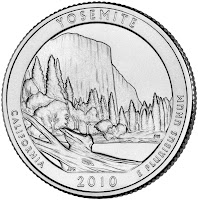 On July 29, 2010, US Mint director Ed Moy introduced the Yosemite National Park Quarter at the park in California. The coin fathers the image of El Capitan, the 3,000-foot vertical rock formation that is prominent formation that looms over Yosemite Valley.
On July 29, 2010, US Mint director Ed Moy introduced the Yosemite National Park Quarter at the park in California. The coin fathers the image of El Capitan, the 3,000-foot vertical rock formation that is prominent formation that looms over Yosemite Valley.
Prior to being discovered by European-Americans in 1833, the Ahwahneechee people inhabited Yosemite Valley. As the gold-rush expanded the non-native population, U.S. troops burned Ahwahneechee villages in 1851, eventually driving them out of the valley. Within a few years, the lack of gold lead to entrepreneurs to use early photographs of the area to turn the area into a tourist destination.
By 1864, the commercial use of the area became a concern. Prominent citizens lobbied congress to pass a bill to declare the area a national park. The bill creating the Yosemite Grand was signed by President Abraham Lincoln on June 30, 1864. Yosemite Grant was managed by the Army until the National Park Service was created in 1916.
A coin exchange and roll sale followed the launch ceremony.
The following video of the launch ceremony was released by the U.S. Mint:
You can find the B-Roll package at NewsInfusion.com.
Coin image courtesy of the U.S. Mint.
Jun 3, 2010 | coins, national park quarters, US Mint, video
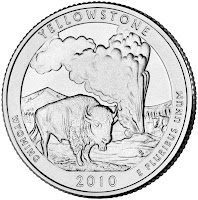 While the U.S. Mint fights trademark issues over the name of their program, Director and professional politician Ed Moy travelled to Yellowstone National Park in Wyoming today to launch the Yellowstone National Park Quarter. Moy was joined by Suzanne Lewis, Superintendent of Yellowstone National Park.
While the U.S. Mint fights trademark issues over the name of their program, Director and professional politician Ed Moy travelled to Yellowstone National Park in Wyoming today to launch the Yellowstone National Park Quarter. Moy was joined by Suzanne Lewis, Superintendent of Yellowstone National Park.
Yellowstone National Park was established by an act of congress on March 1, 1872. Its 2.2 million acres is home to grizzly bears, elk, wolves, and bison. Along with the Old Faithful Geyser are a collection of an extraordinary group of geysers that do not receive the same press as Old Faithful.
The reverse of the coin features Old Faithful Geyser and a bison, both excellent representatives of the nation’s second National Park.
Here is the B-roll video from the U.S. Mint and the launch ceremony:
Quarter image Courtesy of the U.S. Mint
May 31, 2010 | legal, national park quarters, US Mint
According to the lawyers at the U.S. Mint, the term “America the Beautiful” cannot be used when referring to the quarter series without noting that it is a trademark.
Coin World is reporting that Numismatic Guarantee Corporation will change the labels they use on certified 2010 quarters to remove “America The Beautiful” from across the top because the lawyers at the U.S. Mint complained.
According to registered trademark number 77823874, the trademark is for the term America the Beautiful Quarter™ with the disclaimer “No claim is made to the exclusive right to use America or Quarters apart from the mark as shown.”
Although NGC said that they would not fight the request, NGC’s original label did not use the word “Quarter” and is well within the spirit of what was written in the trademark application.
Prior to the quarters program, many of us knew America the Beautiful as the patriotic song based on the poem by Katharine Lee Bates and music by Samuel A. Ward. We also knew the phenomenal rendition by the late Ray Charles. Does the U.S. Mint’s actions mean that Charles’s estate can issue a cease and desist order against the U.S. Mint?
But did you know there was a documentary titled America the Beautiful asking whether is America obsessed with beauty? The film had a limited release in 2008. Does this mean that the U.S. Mint is infringing on the filmmakers copyright?
Will the U.S. Mint and the United States Geologic Survey become entangled in an inter-Executive Branch tussle over the name? The USGS sells the “America The Beautiful – The National Parks and Federal Recreational Lands Annual Pass.” that allows the holder to use these lands without paying an additional fee. Will this be the case of prior usage when the Department of the Treasury fights it out with the Department of the Interior? DoI may not be in a good mood given their involvement with the current disaster in the Gulf of Mexico.
This is an overzealous prosecution by the U.S. Mint’s Office of Chief Counsel (OCC). It appears that the U.S. Mint is taking a common phrase out of the American lexicon and claiming it as their exclusive rights. In the process, OCC is using legal antagonism against the secondary market that serves the collecting community who is being asked to buy these coins.
Considering the reduction in sales caused by the “Great Recession” and collector fatigue over yet another series, it is not in the U.S. Mint’s interest to alienate the collecting community. I urge the U.S. Mint to reread Bates’s historic poem and reconsider its actions regarding a name.
AMERICA THE BEAUTIFUL!
Not a trademark but a sentiment.










